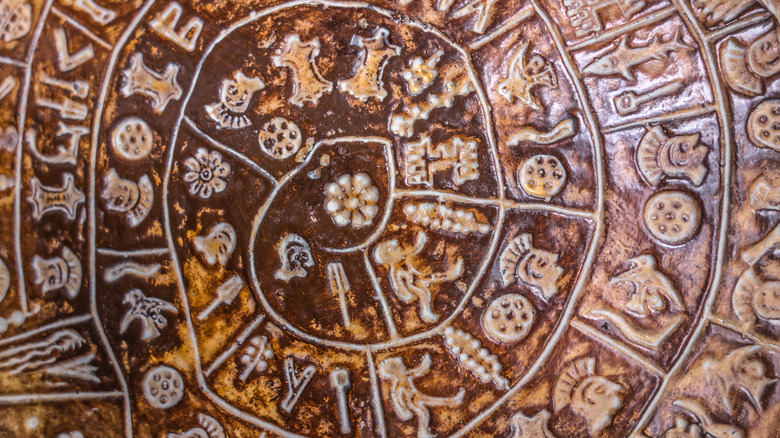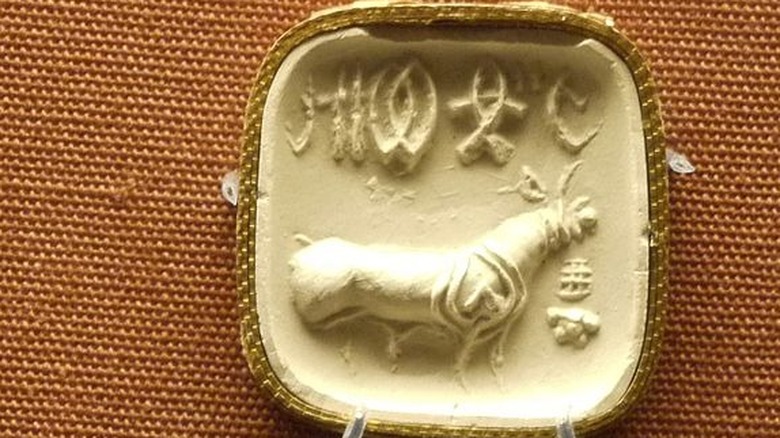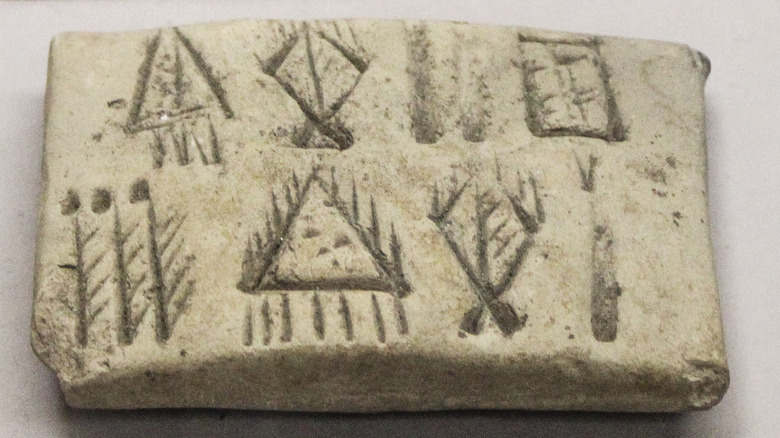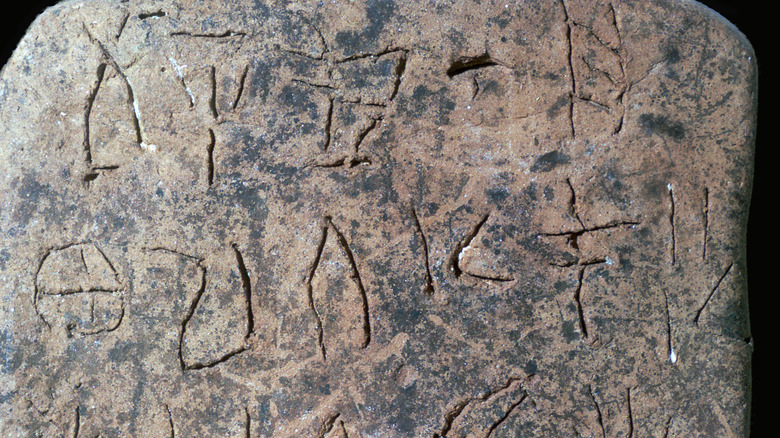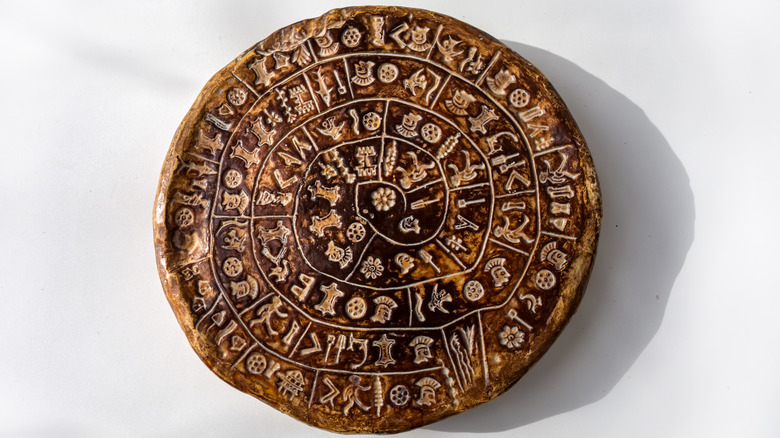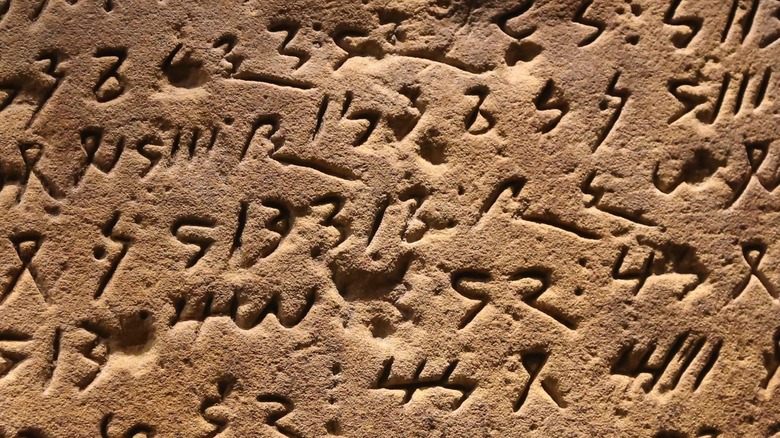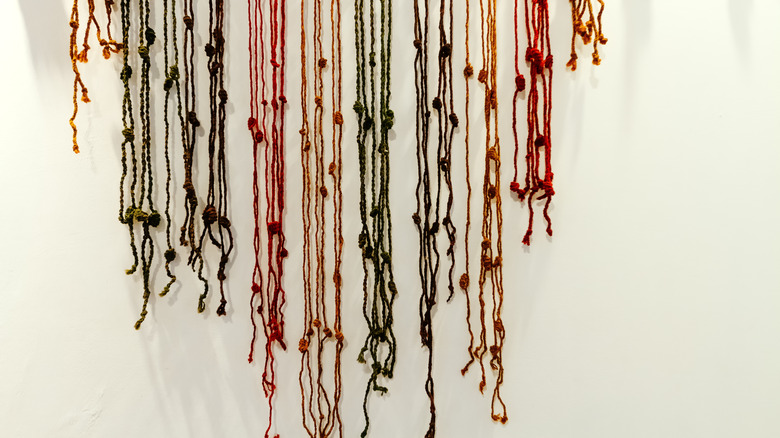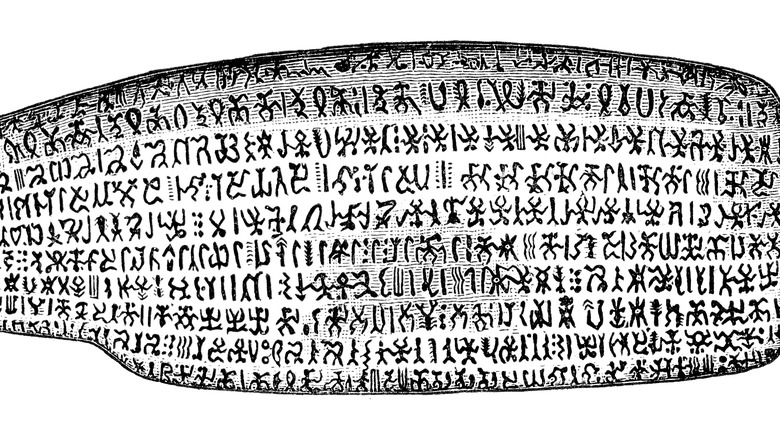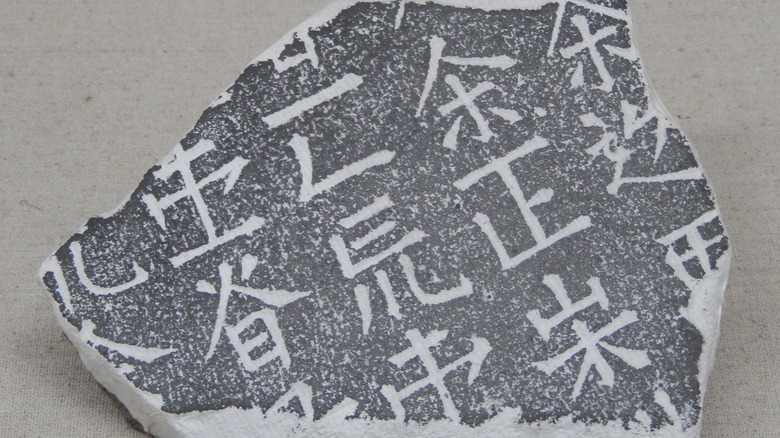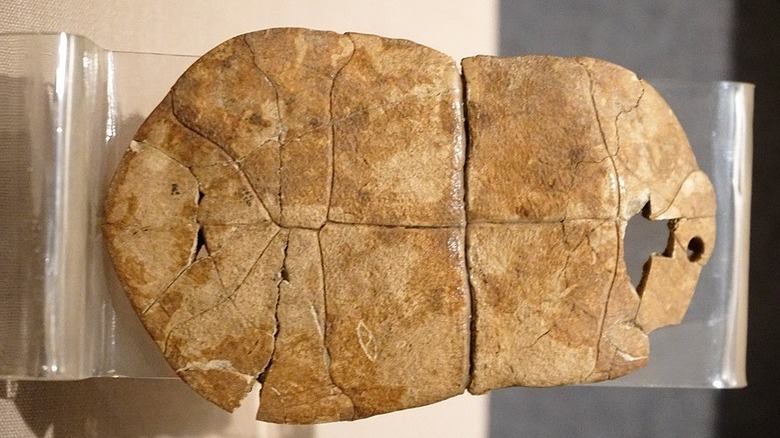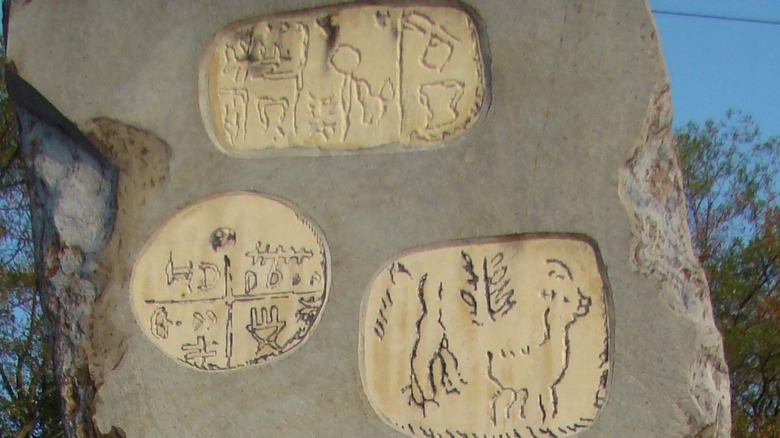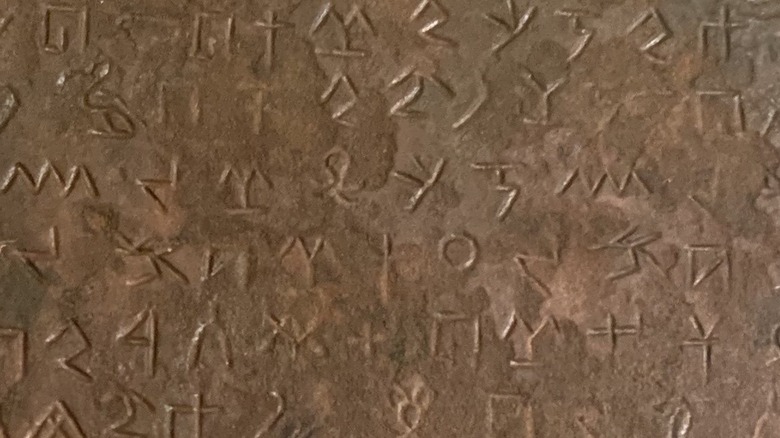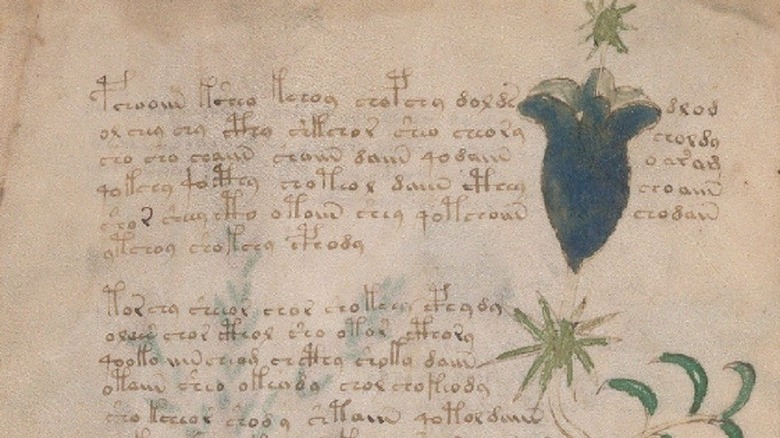Writing Systems That Still Haven't Been Figured Out
Civilization would not exist as we know it without writing. Without it, you could never read the nutritional information on that bag of Cool Ranch Doritos you may enjoy, or select the latest clickbait on Prince Harry and Meghan. But most important of all, you would not have the passed-down knowledge of the generations before you. Writing is what has allowed humans to change the world (for good or ill) over thousands of generations. But the truth is that there is much we don't know about our past because there are writing systems that still baffle the experts.
There are a bunch of complexities in writing systems. Writing can be based on either sounds or meanings. For example, our garden-variety alphabet is a sound-based system since each letter indicates a sound. Other sound-based writing systems may have symbols that represent syllables. Some may be a combination of the two. In a meaning-based system, the symbol can represent an idea or a word. For example, ancient Egyptian hieroglyphics often represent an idea, but to show how complex writing systems are, these also could represent a sound or sounds.
This has made some writing systems truly difficult to figure out and until experts do, our knowledge of the people who used them will remain dim. Let's take a look at some of them.
Indus Valley civilization script
One of the earliest civilizations was in the Indus Valley in today's Pakistan. Also known as the Harappan civilization, it originated some 4,500 years ago and was a contemporary of the civilizations in Mesopotamia and Egypt. In fact, artifacts tell us that the Harappans traded with Mesopotamia. They were quite advanced, too, with their buildings containing such amenities as indoor plumbing. The problem for moderns is that, if you obtained an Indus Valley plumbing manual to unclog a toilet, you would have no way to understand it.
The Indus Valley civilization's writing system contained over 400 different symbols. These are found on a variety of artifacts, including tags used on trade goods. Nobody knows what they mean, though that doesn't stop people from trying to decipher them. Experts have counted the occurrences of the symbols and have concluded that, because so few symbols appear numerous times on solid artifacts, most writing must have occurred on materials that could not withstand the test of time, such as palm leaves.
The chances of deciphering this writing system are slim. One major obstacle is that there is no bilingual example of an Indus Valley text next to a known writing system, such as the Rosetta Stone that was used to decipher Egyptian hieroglyphics. The other problem is that experts have no clue what original language the signs represent. This problem will continue to make the ancient Indus Valley a mystery.
[Image by Geni via Wikimedia Commons | Cropped and scaled | CC BY-SA 4.0]
Proto-Elamite
The Elamites lived in the south of today's Iran from about 3200 to 530 B.C. Their history is divided into different periods, with the most ancient being the Proto-Elamite, which lasted until 2700 B.C. During this time, the Elamites used a linear-script writing system known as Proto-Elamite, which was eventually replaced when they adopted the cuneiform favored by the Sumerians of Mesopotamia.
In "The World's Writing Systems," Robert K. Englund outlines what is known of this forgotten script. There are numerous examples of the writing, which appears on more than 1,400 clay tablets. The symbols — including the so-called "Hairy Triangle" (pictured) — are thought to represent ideas and numbers, and the documents seem to be merely administrative records rather than any great work of ancient literature. The reasons why scholars believe this is that typically after each entry there is a number attached to the symbol, which leads them to conclude that it was used for bookkeeping. However, efforts to decipher Proto-Elamite have not yielded results, despite linguistic experts working on the problem since the early 20th century.
There is some hope that Proto-Elamite may be understood one day. In 2022, the American Society of Overseas Research reported that the more recent Linear Elamite script was deciphered by a team of scholars. This writing is often thought to be related to Proto-Elamite. Time will tell if this is a correct assumption.
[Image by Zunkir via Wikimedia Commons | Cropped and scaled | CC BY-SA 4.0]
Linear A
In the early 20th century, the British archaeologist Sir Arthur Evans discovered a hitherto unknown civilization on the island of Crete. He dubbed it the Minoan civilization after the Greek myth of King Minos. What these Minoans called themselves is unknown since their writing system, Linear A, remains undeciphered. Linear A is thought to have been developed around 1700 B.C. This left-to-right writing system contains up to 85 symbols, which is more than a typical alphabet but less than a full-on ideogram system such as Chinese. Because of the number of symbols, scholars believe that Linear A is a syllabary, with each symbol representing a syllable.
One challenge of deciphering Linear A is that the language of the Minoans is completely unknown. There is speculation that the Minoan language is related to Greek, while other researchers think it's something completely different. Either way, the truth is unknown. Those who have attempted decipherment have analyzed the writing through its use and placement on structures and artifacts. This has led them to conclude that Linear A was used mainly for accounting purposes. Linear A was replaced by 1450 B.C. with the related script Linear B, which was used by the Mycenaeans. Linear B was deciphered in 1952, when it was found to be a dialect of Greek. However, Linear A still eludes scholars since the language it represents is different.
The Phaistos Disc
In 1908, among the ruins of the Minoan palace of Phaistos on Crete, archaeologists found a remarkable and mysterious artifact: a clay disc measuring a little over 6 inches in diameter, covered not with the Linear A script of the Minoans but rather with strange and unknown symbols arranged in a spiral. Since then, this Phaistos Disc has become an object of fascination for scholars and simply those who like to speculate.
Most experts believe that the symbols represent the writing system of the Minoans of that time, which is figured to be anywhere from 1850 to 1550 B.C. While there are 242 total symbols, there are only 45 different types. These symbols have not appeared in other Minoan artifacts of the period, although in a couple of cases there have been similar ones. Also among the symbols are dashes and dots that seem to indicate some sort of grammar or punctuation. Because of the variety of symbols, it is thought that there are too many to represent an alphabet but too few to represent a pictographic script, which makes experts conclude the symbols are a syllabary. But the arrangement and distribution of the symbols compared to other known syllabaries makes it seem unlikely. It may very well be a combination of a pictographic and syllabary system, but its true meaning may never be known.
Meroitic
In today's Sudan, along the east bank of the Nile River, was the ancient city of Meroe, which was part of the Kingdom of Kush. These people developed a writing system that was used from 200 B.C. to the fourth century, which has subsequently become forgotten in the streams of time.
There were two language scripts used in Meroe, both of which were clearly influenced by their northern Egyptian neighbors. One was a linear version, and the other a hieroglyphic one. Both of these were deciphered in the early 20th century by Francis Llewellyn Griffith. While at first blush this may seem like a closed case, the problem is one of linguistics. Meroitic is a lost language that is seemingly unrelated to known languages both ancient and modern. This is regrettable, since there seems to be a fairly large corpus of funerary texts that would inform us about this civilization's culture, if we could read them. Writing in the UCLA Encyclopedia of Egyptology, Claude Rilly states, "...only rare stereotyped passages, such as initial royal protocols and lists of enemies killed in battle and of captured women and livestock, can be even partially understood." In sum, only about a hundred words of Meroitic have been deciphered.
[Image by Rufus46 via Wikimedia Commons | Cropped and scaled | CC BY-SA 3.0]
Incan Khipus
One writing system that is different from any other in world history is the khipu (sometimes spelled "quipu") system developed by the Inca of South America. Khipus were knotted cords that were used for accounting purposes in maintaining inventories of supplies, with knots representing numbers. There were historical claims from Spanish colonists that khipus were also used to record non-numerical texts such as letters and histories. If this is true, then khipus would be the world's only known three-dimensional writing system. Understanding khipus is fairly self-explanatory once you get the hang of the system. For example, Aeon explains that the number 7 was represented by a knot with seven loops.
While the use of numbers in khipus is well known, it has not yet been figured out how they may have been used in non-numerical ways. It is presumed that color, fabric, patterns, and type of knots may have all played a part in the system. This demonstrates the cleverness of the Inca, who invented a writing system that is not dependent on inscription tools and writing media. However, if the khipus do indeed hold information beyond numbers, it still has to be worked out, and the task of doing so might depend on computers.
Rongorongo
Rapa Nui, named "Easter Island" by Europeans, is one of the most remote islands of the South Pacific. Most people who know anything about Easter Island think of the mysterious moai statues which depict immense human heads. Scholars have speculated for years how the islanders created and placed such monumental structures. Just as mysterious is Rapa Nui's writing system, rongorongo.
It is not clear when rongorongo was first invented, but some scholars have speculated that it was only devised after the islanders had contact with Europeans in the 18th century and were inspired by the writing they brought with them. However, it also may have been a completely independently developed writing system. Whichever the case, the script itself has as many as several hundred characters of a pictorial nature. Sadly, knowledge of rongorongo was lost after 19th-century Peruvian slave-capturing expeditions set off a cascade of events, including the introduction of devastating diseases, that wiped out those who knew how to read the characters. Islanders continued to carve rongorongo glyphs thereafter without knowing the meaning of the symbols. When the first attempt to record the writing's meaning was made in 1866, there was no one left who could provide that information.
The decipherment of this forgotten writing system has been ongoing and while there has been progress, it still remains largely as mysterious as the island's statues.
Khitan
The Khitan were a people of the Asian steppe who grew into a powerful state between A.D. 907 and 1125, when they ruled parts of Northern China, Mongolia, and Manchuria. In China, they founded the Liao dynasty. According to the "Encyclopedia of Language and Linguistics" (edited by E.K. Brown), the Khitan ruler Abaoji ordered the creation of a writing system for the new dynasty. The result, which was clearly influenced by the look of the Chinese writing system, was two scripts: one large and one small.
The Khitan declined and fully collapsed during the Mongol conquests of the 13th century. Their language and writing system became lost to history. According to Zev Handel's "Sinography: The Borrowing and Adaptation of the Chinese Script," the late 20th century saw a revival of interest in deciphering what remained of the scripts. While some progress has been made with the small script, it is still only partially understood, and the large script perplexes philologists even more. In their efforts to decipher Khitan script, researchers face two challenges. First, there is not a large amount of surviving text to work with. Second, the Khitan language itself is extinct.
[Image by BabelStone via Wikimedia Commons | Cropped and scaled | CC BY-SA 3.0]
Jiahu Symbols
The earliest evidence of writing in China dates as far back as 9,000 years ago in what is now the Henan Province, at the site of Jiahu. There, archaeologists have found tortoise shells, pottery, and tools that have undeciphered symbols inscribed upon them. These symbols may be an ancestor of a tradition from the later Shang dynasty in which people took tortoise shells and inscribed questions on them. These "oracle bones" were then cast into a fire whose heat created cracks that were used to divine the answer to the question. The cracks were then drawn on the shells and were the long-assumed earliest example of Chinese characters. The findings at Jiahu indicate a much longer tradition.
There are 16 symbols found on the Jiahu artifacts. In his work "The Guardian of All Things," Michael Shawn Malone notes that this writing is probably a type of proto-writing because none of the symbols seem to relate to one another.
[Image by Cangminzho via Wikimedia Commons | Cropped and scaled | CC BY-SA 4.0]
Vinča symbols
In southeastern Europe there existed an advanced Neolithic society that may have created one of the first writing systems. Vinča culture, also called Turdaș culture, reached a peak from 5500 to 4000 B.C. in the area now known as the Balkans and was ahead of its time in agriculture, metal-working, and other disciplines.
Carved onto many of their artifacts are symbols that, according to Toby D. Griffen in "Deciphering the Vinča Script," may be design motifs, proto-writing, or both. Most intriguing of all these artifacts are the Tartaria Tablets. These three tablets, which are named after the village in which they were found, feature undeciphered symbols and might predate the writing systems of Mesopotamia. However significant this discovery is, there have been some in the scholarly community who have contended that the tablets are nothing but a modern hoax.
Unfortunately for researchers, trying to decipher this proto-writing system may prove nearly impossible since the figures are unrelated to any other known writing system in existence. However, if this feat is accomplished, it could greatly enhance our knowledge of prehistoric cultures.
[Image by Țetcu Mircea Rareș via Wikimedia Commons | Cropped | CC BY-SA 3.0]
Byblos script
In high school social studies, if students learn anything about the Phoenicians, it is that their alphabet was widely adopted throughout the Mediterranean region. This alphabet is the forerunner of many modern alphabets, including the one you are reading right now.
The Phoenician city-state of Byblos, which was located in what is today's Lebanon, developed a separate writing system as early as 2000 B.C., according to "Lost Languages from the Mediterranean." This seems to predate the Phoenician alphabet by 1,000 years. I It is found on stone, bronze, and spatulas, of all things. It does not seem to be in any way related to the later Phoenician alphabet, and it has yet to be deciphered.
"Ancient Egyptian Society" (edited by Danielle Candelora et al.) reports that the Byblos script seems to be a hybrid of hieroglyphs inspired by the ancient Egyptians and other emerging alphabets. Other experts, such as Andrew Robinson in "Writing and Script," assert that there are similarities between it and Minoan Linear A, which may have had an equal influence in its development. What is known is that it has too many unique symbols to be an alphabet and is more likely a syllabary.
[Image by Onceinawhile via Wikimedia Commons | Cropped | CC BY-SA 4.0]
Voynich Manuscript script
There is one writing system that is so puzzling that even the National Security Agency has brooded over it for years. This is the so-called "Voynich Manuscript" which now resides at Yale University. This codex dates perhaps to the late 15th century and contains fantastical images of unknown flora and fauna that have completely baffled anyone who looks at it.
One part of the mystery is its unknown writing system. The manuscript has what is seemingly an alphabet comprising up to 30 characters, written left to right. Most scholars who climb down the Voynich rabbit hole, such as M.E. D'Imperio, author of "The Voynich Manuscript: An Elegant Enigma," believe that the number of characters can only indicate an alphabet. What is more, it is often assumed that the Voynichese symbols are substitutes for characters from a known alphabet. The problem is that nobody has been able to figure out which alphabet nor can they determine which original language it may be a cipher of.
The frustration is such that many have contended that the manuscript is a complete hoax. Even if it is a hoax, it is one of the most thorough and convincing fabrications of all time.
